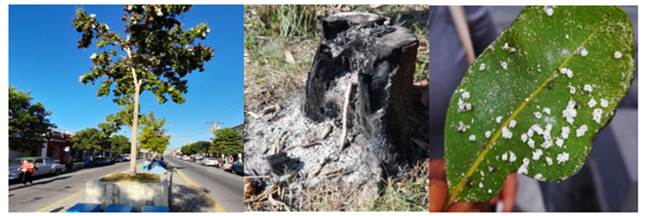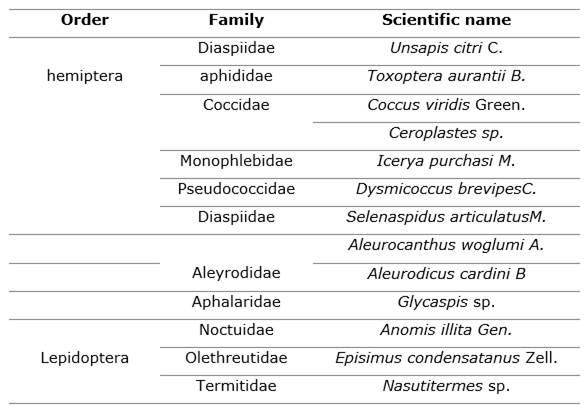Mi SciELO
Servicios Personalizados
Articulo
Indicadores
-
 Citado por SciELO
Citado por SciELO
Links relacionados
-
 Similares en
SciELO
Similares en
SciELO
Compartir
Revista Cubana de Ciencias Forestales
versión On-line ISSN 2310-3469
Rev cubana ciencias forestales vol.10 no.2 Pinar del Río mayo.-ago. 2022 Epub 06-Ago-2022
Original article
Harmful organisms in urban trees in the city of Pinar del Río, Cuba
1Universidad de Pinar del Río "Hermanos Saíz Montes de Oca". Pinar del Río, Cuba.
The present study was carried out in the neighborhoods "Hermanos Cruz", "Carlos Manuel", "Montequín" and "Calle Martí" belonging to the municipality of Pinar del Río, with the aim of identifying causal plague organisms associated with urban trees in the city of Pinar del Rio, Cuba. A floristic inventory of forest trees was carried out up to the family and species level, as well as the collection of samples of plant organs with symptoms of parasitic diseases and/or the presence of phytophagous insects. The inventory of urban trees in the city of Pinar del Río revealed 13 forest species belonging to 9 botanical families and 12 genera. The most represented family was Meliaceae. In addition, the "Hermanos Cruz" distribution presented a greater abundance of forest species. The species of urban trees serve as hosts to 21 harmful organisms that include eight causal agents of parasitic diseases, 3 orders, 11 families and 13 species of phytophagous insects, with a greater representation of Hemiptera and Lepidoptera. Harmful organisms showed a greater presence in the forest species like Callophylum antillanum, Grevillea robusta, Acasia mangium, Hibiscus elatus, Gmelina arborea, Tectona grandis y Eucaliptus sp.
Key words: Phytophagous insects; Effects; Parasitic diseases; Forest species.
INTRODUCTION
Public green spaces fulfill several functions. Their aesthetic value creates pleasant spaces to live. They also improve air quality by trapping polluting particles and substances, prevent erosion, and attenuate auditory impact. Moreover, they play an important role in recreation and distraction. Therefore, it is justified to make efforts to implement and keep them from the municipal management (Bahamonde et al., 2018), where tree species play an important role.
It can be said that urban trees generate innumerable contributions to the city at all levels, both social, economic, ecological, environmental, cultural and in terms of human health (Molina and Acosta 2018).
In order to secure its proper management and handling, it is essential to know the species that compose it. The purpose of the sampling is to identify the phytophagous species that, due to their high reproductive potential, take on the character of a pest and cause serious damage to the plants they feed on. They also provoke economic losses due to the deterioration of urban furniture, inconvenience to users, and in very specific cases, can negatively affect people's health (Hernández and Marcos 2019).
To fulfill those functions, the planted trees must be healthy, have bright green or matte foliage according to their species and have all their branches growing at an expected annual rate for the species in the environment where they grow. Besides, their trunk must not present cracks; neither inclines nor important bifurcations and not expel liquids by scars, nor be affected by sooty mold. A healthy tree, in general, does not have a significant insect population and its percentage of dry branches is low (<10 %) (Bahamonde et al., 2018).
The trees of the city of Pinar Río do not meet the characteristics indicated in the category of a healthy tree. Hence the research was aimed at identifying the causal organisms of plague that are associated with these forest species.
MATERIALS AND METHODS
Description of the research scenarios
The investigation was carried out in "Calle Martí" and the districts "Hermanos Cruz", "Carlos Manuel" and "Montequín", belonging to the municipality of Pinar del Río. Almost all of these scenarios present settlements dominated by buildings, parks and/or uninhabited land where vegetation prevails, mostly forest species.
The determination of the forest species involved within the urban trees in the evaluated areas was carried out through an inventory, in September 2021, considering each green zone and other public spaces (Tabla 1).
Table 1. - Coordinates of the points sampled in the selected green areas
| Urban venues | Geographic location |
|---|---|
| Martí Street (it covers the main avenue from the Tranquilino Sandalio de Noda Museum of Natural Sciences to the Café Ortúzar Restaurant) | 22°24'51 |
| Cast Carlos Manuel (Comandante Pinares Street) | 22°24'59''N 83°41'26''O |
| Hermanos Cruz distribution (covers Calle Colón to Avenida Borrego) | 22°25'17 |
| Montequín neighborhood (Central Highway in front of Abel Santamaría Cuadrado Hospital) | 22°26'26 |
In each evaluated area, the species of forest interest were recorded and counted. The floristic inventory was developed from the count and taxonomic identification, up to the family and species level, of the tree plants of forest interest present in the different urban venues and areas with vegetation (Betancourt 2000).
Methodology for the identification of pests associated with tree species of forest interest
The causal agents of diseases were identified using the keys proposed by Hernández (1985). The taxonomic determination of the phytophagous insects found was carried out using the taxonomic keys of Cibrián et al. (2007) and data available in CABI (2007). It was also considered, in all cases, the recognition or presumptive diagnosis of these directly in the urban venues evaluated.
The identification and characterization of the specimens was carried out using a Novel® stereoscopic microscope, tweezers, scalpels, among other instruments which allowed the development of dissections, as well as comparisons with existing keys. Those immature stages collected were kept under laboratory conditions, artificially fed until their life cycle is completed with the arrival of an adult insect.
Samples were collected in all the evaluations; each sample was duly labeled with the data corresponding to the forest species and date of collection. In the same way, data and comments that were considered pertinent were taken, at the time of their collection, due to their interest for the determination of the species of harmful organisms, the methodology proposed by Miranda (2011) was considered.
RESULTS AND DISCUSSION
Thirteen forest species were identified in the urban sites evaluated, consisting in six native species (46 %) and seven exotic (54 %), which were grouped into 9 botanical families, 12 genera and 778 individuals (Table 2). Urban green spaces are small ecosystems, although fragmented, they represent a reservoir of biodiversity (Egerer et al., 2018).
These results coincide with Jiménez et al. (2015), in studies carried out in the urban trees of Plaza de la Revolución in Havana, Cuba. However, Rodríguez et al. (2018) identified a total of 24 families, 36 species and 1259 individuals in the urban woodland of the city of Guantánamo, Cuba.
Table 2. - Tree species of forest interest identified in the urban trees of the city of Pinar del Río
| Family | Scientific name |
| Verbenaceae |
|
| Meliaceae |
|
| Meliaceae |
|
| Meliaceae |
|
| Meliaceae |
|
| Malvaceae |
|
| cluseaceae |
|
| Myrtaceae |
|
| Boraginaceae |
|
| Fabaceae |
|
| Proteaceae |
|
| Pinaceae |
|
| Verbenaceae |
|
They stand out for the number of species that group the families Meliaceae (four) and Verbenaceae (two species), the other families were represented by one species (Table 2). Hernández et al. (2019) recorded lower results for Meliaceae with two species. The results also highlight a greater abundance of individuals by species than species by family.
The greatest abundance of forest species was recorded in the "Hermanos Cruz" distribution, with the presence of the 13 inventoried forest species and 450 individuals. These results may be associated with the distribution of the species in the main streets of the city of Pinar del Río (Figure 1), in addition to the poor management of trees, which leads to the loss and deterioration of established species.
The trees that inhabit urban environments daily face stressful and precarious conditions, in hostile environments that limit their proper development, which affects their ability to offer the environmental services that a healthy individual could provide (Gilioli et al., 2014).
There is a lack of divulgation and training towards the population about the benefits and importance of trees for the city and for improving the life quality of the inhabitants. Society recognizes in trees mainly their decorative or scenic value and their role in generating shade, leaving aside the rest of the services they provide to cities (Avellán 2020).
Harmful organisms in forest species in urban venues
Regarding the diseases, 8 causal agents of pests were identified (Table 3), in H. elatus, G. robusta and A. mangiun the characteristic symptoms of gangrene and gummosis in G. robusta consist of cracking of the bark that affects the xylem and abundant gummy secretion of a brown color. A. mangium trees also exhibited brown gummosis and bark cracking.
The most severe symptoms produced by parasitic diseases were observed in trees of H. elatus and G. robusta(Figure 2), with great damage caused by gangrene. According to Andreu et al. (2007), the pathogen that causes this disease is a fungus that has not yet been classified, although it belongs to the Ascomnycetes Class, Hipocraceae family.
Table 3. - Parasitic diseases detected in the evaluated forest species
| causal agents | host plant |
| Olivea tectonae | |
|
|
|
| Unidentified | |
| Unidentified | australian oak |
| Unidentified |
Eucalyptus sp. showed severe damage caused by C. cubensis. Soares et al. (2018) state that cankers are found on tree trunks and branches, and can reduce growth and cause plant death. Eucalyptus canker is one of the most limiting diseases for plantations in the tropical region (Chocontá et al., 2017).
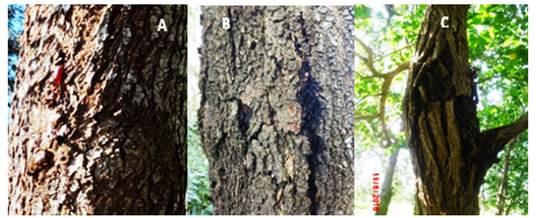
Fig. 2. - Gummosis and bark cracking in Grevillea robusta (A), Gummosis and bark cracking in Acacia mangium (B) and Gangrene in Hibiscus elatus (C)
O. tectonae caused severe defoliation symptoms in the teak (Figure 3 B, and C). The rust produces an almost total defoliation of the trees, affecting the photosynthesis process in the plant, but once the infection period has elapsed, they recover and sprout new leaves (Cibrián et al., 2007).
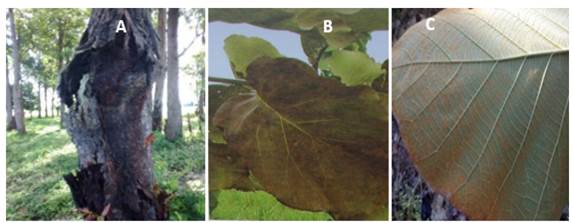
Fig. 3. - Eucalyptus sp. tree affected by gangrene (A), leaves with green-brown necrotic areas (B) and orange spores of the fungus on the underside of the leaves (C)
K. nyasica trees, the presence of X. rubrilineans was observedFigure 4: A). Although this disease gives an ugly appearance to the tree, over time the galls detach, the trees recover and acquire a certain degree of immunity (Hernández, 1985). In this species, the manifestation of gummosis on the trunk, produced by the fungus Tubercularia sp.
Capnodium sp. manifested itself in the form of black crusts on the surface of the Callophylum antillanum leaves, reducing their photosynthetic area. The fungi that cause this disease are saprophytes obliged to feed on honeydew excreted by sucking stinging insects of the order Hemiptera.
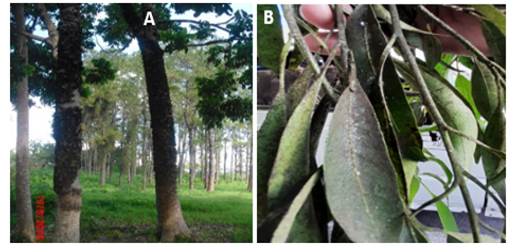
Fig. 4. - Hypertrophy on trunks and branches in the form of galls (A) and (B) sooty mold on Cordia gerascanthus leaves
Regarding phytophagous insects, 3 orders, 11 families and 13 species were recorded (Table 4). The highest species richness was recorded in the orders Hemiptera (9) and Lepidoptera (3), while the most represented families were Coccidae and Aleyrodidae with two species, respectively.
Similar results were obtained by Méndez (2017), since they found a greater number of families and species in Lepidoptera and Hemiptera.
Reséndiz et al. (2019) in urban spaces identified 45 species, included in 34 genera, 18 families and six orders of phytophagous insects.
The Hemiptera order expressed the highest presence of insects in the evaluated forest species, showing greater preference in C. antillanum, A. mangium, G. arborea and C. gerascanthus, which shows that these species could be the most affected by these organisms.
Reséndiz et al. (2019) in urban spaces reported species of phytophagous insects, mostly Hemiptera, with families such as Aphididae, Coccidae, Aleyrodidae and Diaspididae, among others.
These individuals usually suck their food mainly from the leaves, tender twigs, developed branches, floral bearings and fruits (Valerazo et al., 2012), in which they find elaborated sap, a fluid composed of simple carbohydrates such as sucrose, glucose and fructose, from which insects take high volumes (Figura 5) (Cano 2013).

Fig. 5. - Images of Hemiptera in Ocuje: Dysmicoccus brevipes (A), Ceroplastes sp. (B), Aleurodicus cardini (C), Icerya purchasi (C), and Toxoptera aurantii (E)
Frank et al. (2019) assures that, when selecting trees for urban woodland, the susceptibility to pests of native species must be weighed against the benefit for the conservation of native urban insect fauna (Figura 6).

Fig. 6. - Images of Aleurodicus cardini in Acasia (A); Aleurocanthus woglumi (B) and Dysmicoccus brevipes in Baría (C)
Frank et al. (2019) affirms that both the harmful and beneficial fauna that is housed by urban trees, in addition to the geographical origin, respond to the environmental conditions generated in urban environments. In such a way that, to favor conservation and avoid the loss of environmental services in urban trees due to harmful agents, it is necessary to establish a balance between exotic and native species.
Regarding the presence of harmful organisms in forest species, it was found that C. antillanum, G. robusta, A. mangium, H. elatus and G. arborea, presented a greater presence of phytophagous insects, while the species C. antillanum, T. grandis, G. robusta, H. elatus and Eucaliptus sp., showed a higher presence of pathogens.
The reduced diversification of plant species in some parts of the cities, and even worse, the dominance of a single species, favors the incidence of pest organisms (Paap et al., 2017).
CONCLUSIONS
The urban woodland of the city of Pinar del Río is made up of 13 forest species belonging to nine botanical families and 12 genera. The most represented family is Meliaceae; while the "Hermanos Cruz" distribution presents a greater abundance of forest species.
The species of urban trees serve as hosts to 21 harmful organisms that include eight causal agents of parasitic diseases, three orders, 11 families and 13 species of phytophagous insects, with a greater representation of Hemiptera and Lepidoptera.
Harmful organisms show a greater presence in the forest species Callophylum antillanum, Grevillea robusta, Acasia mangium, Hibiscus elatus, Gmelina arborea, Tectona grandis and Eucaliptus sp.
REFERENCIAS BIBLIOGRÁFICAS
ANDREU RODRÍGUEZ, C.M., 2007. La sanidad vegetal en la agricultura sostenible. Tomo II [en línea]. Santa Clara: Editorial Feijóo. ISBN 978-959-250-446-2. Disponible en: https://cataleg.uji.es/discovery/fulldisplay?vid=34CVA_UJI:VU1&tab=Everything&docid=alma991004367146406336&lang=ca&context=L&adaptor=Local%20Search%20Engine&query=sub,exact,%20Tomatoes%20,AND&mode=advanced [ Links ]
AVELLÁN ZUMBADO, M.J., 2020. Gestión del arbolado urbano en Costa Rica: desafíos y oportunidades. Revista Trimestral sobre la Actualidad Amb [en línea], vol. 275, no. 5, pp. 30-35. ISSN 1409-214X. Disponible en: https://www.ambientico.una.ac.cr/wp-content/uploads /tainacan-items/5/31132/275_30-35.pdf. [ Links ]
BAHAMONDE, H., PERI, P., GARGAGLIONE, V., DIAZ, B., MONELOS, L. y ALMONACID, L., 2019. Arbolado urbano en Patagonia Sur, principales especies y su manejo [en línea]. Argentina: INTA-CAP. ISBN 978-987-46815-1-5. Disponible en: https://www.researchgate.net/publication/335619279_Arbolado_urbano_en_Patagonia_Sur_principales_especies_y_su_manejo. [ Links ]
BARCELÓ, A.M., 2017. Entomofauna principal asociada a plantas de interés agrícola en la provincia de las tunas, Cuba. Ojeando la Agenda [en línea], no. 50, pp. 1. [Consulta: 22/06/2022]. ISSN 1989-6794. Disponible en: Disponible en: https://dialnet.unirioja.es/servlet/articulo?codigo=6266019 . [ Links ]
BARROSO, S.A.B., 2000. Arboles maderables exóticos en Cuba [en línea]. S.l.: Editorial Científico-Técnica. ISBN 978-959-05-0266-8. Disponible en: https://books.google.com.cu/books/about/Arboles_maderables_ex%C3%B3ticos_en_Cuba.html?id=QYkrAAAACAAJ&redir_esc=y. [ Links ]
CABI, 2007. Compendio de Protección de Cultivos. [en línea]. Reino Unido: Wallingford. Disponible en: https://www.cabi.org/Uploads/CABI/publishing/promotional-materials/insert /Cpc%20A4%20Flyer%20Spanish.pdf. [ Links ]
CELY, O.V., BERMÚDEZ, E.C. y NAVARRETE, B., 2012. Artrópodos asociados al cultivo de cacao en Manabí. La Técnica [en línea], no. 7, pp. 34-42. [Consulta: 23/06/2022]. ISSN 1390-6895, 2477-8982. Disponible en: Disponible en: https://dialnet.unirioja.es/servlet/articulo?codigo=6087699 . [ Links ]
CHOCONTÁ LÓPEZ, A., PINZÓN FLORIÁN, O.P. y NIETO RODRÍGUEZ, V.M., 2017. Susceptibilidad y prevalencia de Eucalyptus pellita F.Muell. al cancro causado por Chrysoporthe cubensis (Bruner) Gryzenhout & M. J. Wingf. en la Orinoquia Colombiana. Revista mexicana de ciencias forestales [en línea], vol. 8, no. 42, pp. 150-176. [Consulta: 22/06/2022]. Disponible en: Disponible en: https://www.redalyc.org/journal/634/63454560008/html/ . [ Links ]
CIBRIÁN-TOVAR, D., 2007. Enfermedades forestales en México [en línea]. S.l.: Universidad Autónoma Chapingo. ISBN 978-968-02-0340-6. Disponible en: https://books.google.com.cu/books/about/Enfermedades_forestales_en_M%C3%A9xico.html?id=5VEmAQAAMAAJ&redir_esc=y. [ Links ]
EGERER, M.H., LIERE, H., LIN, B.B., JHA, S., BICHIER, P. y PHILPOTT, S.M., 2018. Herbivore regulation in urban agroecosystems: Direct and indirect effects. Basic and Applied Ecology [en línea], vol. 29, pp. 44-54. [Consulta: 22/06/2022]. ISSN 1439-1791. DOI 10.1016/j.baae.2018.02.006. Disponible en: Disponible en: https://www.sciencedirect.com/science/article/pii/S1439179117303493 . [ Links ]
FRANK, S.D., BACKE, K.M., MCDANIEL, C., GREEN, M., WIDNEY, S. y DUNN, R.R., 2019. Exotic urban trees conserve similar natural enemy communities to native congeners but have fewer pests. PeerJ [en línea], vol. 7, pp. e6531. [Consulta: 22/06/2022]. ISSN 2167-8359. DOI 10.7717/peerj.6531. Disponible en: Disponible en: https://www.ncbi.nlm.nih.gov/pmc/articles/PMC6409088/ . [ Links ]
GILIOLI, G., SCHRADER, G., BAKER, R.H.A., CEGLARSKA, E., KERTÉSZ, V.K., LÖVEI, G., NAVAJAS, M., ROSSI, V., TRAMONTINI, S. y VAN LENTEREN, J.C., 2014. Environmental risk assessment for plant pests: A procedure to evaluate their impacts on ecosystem services. Science of The Total Environment [en línea], vol. 468-469, pp. 475-486. [Consulta: 22/06/2022]. ISSN 0048-9697. DOI 10.1016/j.scitotenv.2013.08.068. Disponible en: Disponible en: https://www.sciencedirect.com/science/article/pii/S0048969713009959 . [ Links ]
HERNÁNDEZ, F.R., 1985. Fitopatología Forestal. Pinar del Río: S.l.: Centro Universitario de Pinar del Río. Ministerio de Educación Superior. [ Links ]
HERNÁNDEZ GUANCHE, L., SANTANA BAÑOS, Y., ACOSTA HERNÁNDEZ, A. y CONCEPCIÓN, A. del B., 2019. Diversidad de especies arbóreas en escenarios de la agricultura urbana en el municipio de Pinar del Río. Revista Cubana de Ciencias Forestales [en línea], vol. 7, no. 2, pp. 212-224. [Consulta: 22/06/2022]. ISSN 2310-3469. Disponible en: Disponible en: http://scielo.sld.cu/scielo.php?script=sci_abstract&pid=S2310-34692019000200212&lng=es&nrm=iso&tlng=es . [ Links ]
JIMÉNEZ, M.M., MANZANARES, K. y MESA, M., 2015. Diagnóstico del arbolado urbano en la Circunscripción 71, Municipio de Plaza de la Revolución, Cuba. Revista Forestal Baracoa, vol. 34, no. 1. [ Links ]
LUÍS GALLEGO, F., 2013. Artrópodos chupadores de savia y mecanismos para su adaptación a nichos deficientes en nutrientes. BOLETIN DEL MUSEO ENTOMOLÓGICO [en línea], vol. 9, no. 1, pp. 8. Disponible en: https://ciencias.medellin.unal.edu.co/museos/entomologico/images/Boletin/2013-03/3.pdf. [ Links ]
MIRANDA, I., 2011. Estadística aplicada a la Sanidad Vegetal. 2011. S.l.: Centro Nacional de Sanidad Vegetal Agropecuaria. [ Links ]
MOLINA-PRIETO, L.F. y HERNÁNDEZ, C.F.A., 2018. Orígenes y evolución de las arborizaciones urbanas en América Latina con énfasis en Bogotá y Medellín. Formas urbanas colonial, republicana y protomoderna. Gestión y Ambiente [en línea], vol. 21, no. 2, pp. 276-290. [Consulta: 22/06/2022]. ISSN 0124-177X, 2357-5905. Disponible en: Disponible en: https://dialnet.unirioja.es/servlet/articulo?codigo=7066300 . [ Links ]
PAAP, T., BURGESS, T. y WINGFIELD, M., 2017. Urban trees: bridge-heads for forest pest invasions and sentinels for early detection. Biological Invasions [en línea], vol. 19, no. 12. [Consulta: 22/06/2022]. DOI 10.1007/s10530-017-1595-x. Disponible en: Disponible en: https://www.researchgate.net/publication/320429409_Urban_trees_bridge -heads_for_forest_pest_invasions_and_sentinels_for_early_detection . [ Links ]
RESÉNDIZ MARTÍNEZ, J.F., GUZMÁNDÍAZ, L., MUÑOZ VIVEROS, A.L., OLVERACORONEL, L.P., PACHECO HERNÁNDEZ, M. de L., ARRIOLA PADILLA, V.J., RESÉNDIZ MARTÍNEZ, J.F., GUZMÁNDÍAZ, L., MUÑOZ VIVEROS, A.L., OLVERACORONEL, L.P., PACHECO HERNÁNDEZ, M. de L. y ARRIOLA PADILLA, V.J., 2019. Insectos y ácaros fitófagos del arbolado en el Parque Recreativo y Cultural Tezozómoc, Azcapotzalco, Ciudad de México. Revista mexicana de ciencias forestales [en línea], vol. 10, no. 56, pp. 149-173. [Consulta: 23 /06/2022]. ISSN 2007-1132. DOI 10.29298/rmcf.v10i56.454. Disponible en: Disponible en: http://www.scielo.org.mx/scielo.php?script=sci_abstract&pid=S2007-11322019000600149&lng=es&nrm=iso&tlng=es . [ Links ]
RODRÍGUEZ MATOS, Y., AJETE HERNÁNDEZ, A., ORTA POZO, S., RONDÓN GONZÁLEZ, D.N., RIVERA DÍAZ, J.R., RODRÍGUEZ MATOS, Y., AJETE HERNÁNDEZ, A., ORTA POZO, S., RONDÓN GONZÁLEZ, D.N. y RIVERA DÍAZ, J.R., 2018. Comportamiento del carbono retenido en el arbolado urbano en el sur de la ciudad de Guantánamo. Revista Cubana de Ciencias Forestales [en línea], vol. 6, no. 3, pp. 284-299. [Consulta: 23 /06/2022]. ISSN 2310-3469. Disponible en: Disponible en: http://scielo.sld.cu/scielo.php?script=sci_abstract&pid=S2310-34692018000300284&lng=es&nrm=iso&tlng=es . [ Links ]
SOARES, T., FERREIRA, M., MAFIA, R., OLIVEIRA, L., HODGES, C. y ALFENAS, A., 2018. Canker disease caused by Chrysoporthe doradensis and C. cubensis on Eucalyptus sp. and Tibouchina spp. in Brazil. Tropical Plant Pathology [en línea], vol. 43. DOI 10.1007/s40858-018-0238-9. Disponible en: https://www.researchgate.net/publication/326729638_Canker_disease_caused_by_Chrysoporthe_doradensis_and_C_cubensis_on_Eucalyptus_sp_and_Tibouchina_spp_in_Brazil. [ Links ]
Received: April 06, 2022; Accepted: July 18, 2022











 texto en
texto en 

